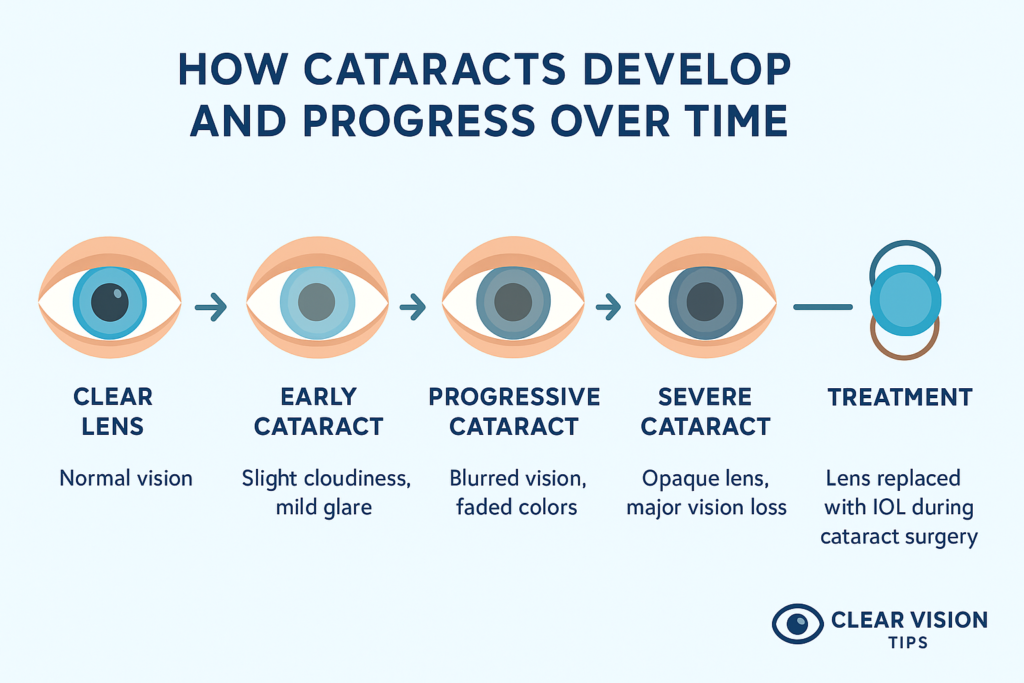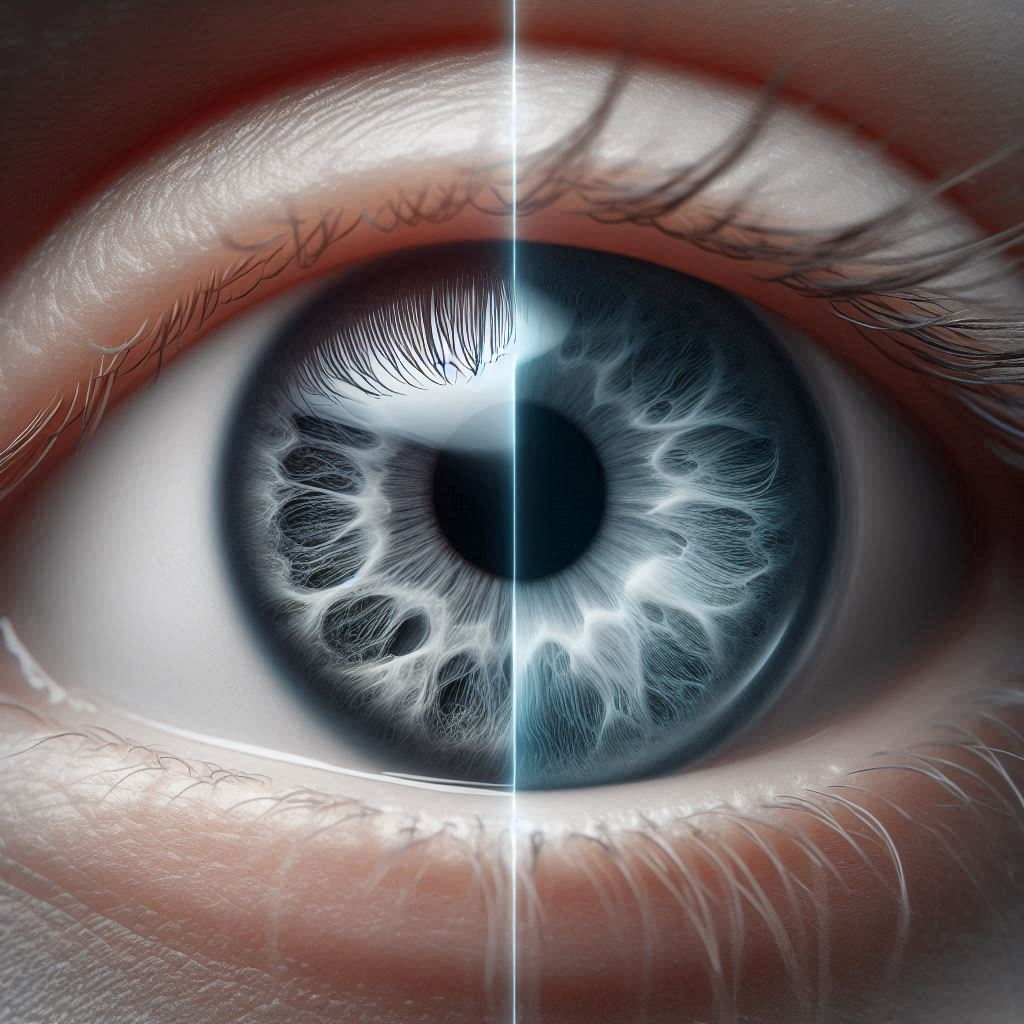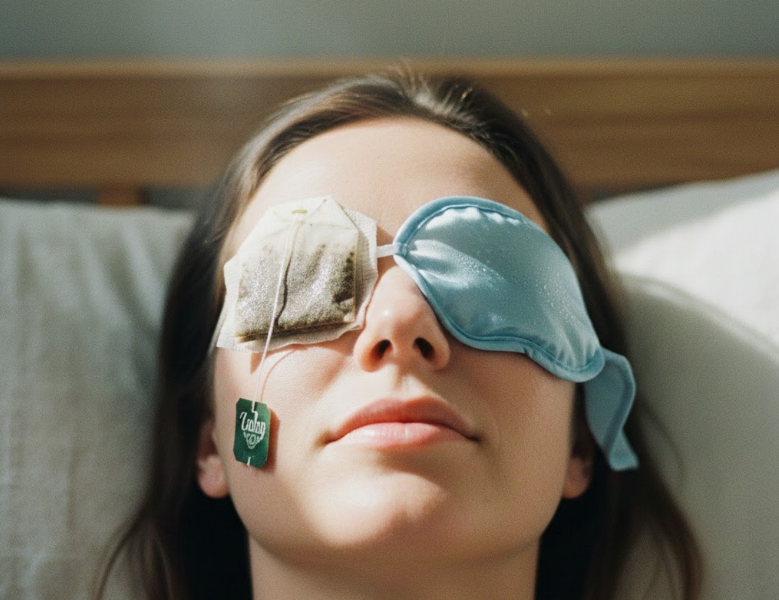Introduction: Why Cataracts Matter
Cataracts are one of the most common causes of vision loss, affecting over 65 million people globally. They occur when the eye’s natural lens becomes cloudy, causing blurred vision and difficulty seeing clearly. Although cataracts are strongly linked to aging, factors such as UV exposure, smoking, and poor nutrition can accelerate their development. The good news is that cataracts are both preventable and highly treatable with modern eye care. Cataracts are one of the
In this article, we’ll explore the causes, risk factors, symptoms, prevention methods, and treatment options for cataracts in detail, while also answering the most common questions patients have.
What Are Cataracts?
A cataract is the clouding of the eye’s natural lens. The lens normally works like a camera lens, focusing light onto the retina for clear vision. Over time, proteins in the lens can break down and clump together, causing cloudy or blurry vision.
There are different types of cataracts:
- Nuclear cataracts – form in the center of the lens, common with aging.
- Cortical cataracts – wedge-shaped opacities around the edges.
- Posterior subcapsular cataracts – form at the back of the lens, progress faster.
- Congenital cataracts – present at birth due to genetics or infections.
Causes of Cataracts
The primary cause of cataracts is aging, but several other factors contribute:
- UV radiation exposure
- Diabetes and metabolic disorders
- Long-term use of corticosteroids
- Eye injuries or trauma
- Genetic predisposition
- Lifestyle factors such as smoking and poor nutrition
How Cataracts Form
When proteins in the lens begin to clump together, they scatter light instead of focusing it properly. This gradual buildup leads to cloudy or foggy vision — the first visible sign of cataract formation.

Symptoms of Cataracts
Cataracts develop gradually and may not be noticeable in the early stages. Common symptoms include:
- Blurred or cloudy vision
- Fading or yellowing of colors
- Difficulty seeing at night
- Sensitivity to glare and bright lights
- Double vision in one eye
- Frequent changes in prescription glasses
💡 Did You Know?
By age 80, more than half of all people either have a cataract or have undergone cataract surgery. With today’s advanced laser-assisted procedures, vision recovery is faster and safer than ever.
Risk Factors
You may be at higher risk for cataracts if you:
- Are over 60 years old
- Have a family history of cataracts
- Spend long hours outdoors without UV protection
- Smoke or drink excessively
- Have diabetes or hypertension
- Experienced prior eye surgery or injury
Prevention of Cataracts
Although not all cataracts can be prevented, certain strategies can significantly lower your risk:
- Wear UV-blocking sunglasses daily
- Eat an antioxidant-rich diet (vitamins A, C, and E)
- Avoid smoking and excessive alcohol
- Manage chronic conditions like diabetes
- Regular eye exams to detect early changes
Nutrition and Lifestyle for Eye Health
Research shows antioxidants like lutein, zeaxanthin, and vitamin C protect lens proteins from oxidative stress. Include:
- Spinach, kale, broccoli, oranges, almonds, salmon
- Reduce sugar and processed foods to prevent diabetic cataracts
✅ Useful Tips for Preventing Cataracts
- Get regular eye exams — early detection is key.
- Eat more leafy greens, carrots, and citrus fruits.
- Protect your eyes from UV rays with sunglasses and hats.
- Limit smoking and alcohol consumption.
- Control chronic conditions like diabetes or hypertension.
Diagnosis of Cataracts
Cataracts are diagnosed during a comprehensive eye exam, which may include:
- Visual acuity test
- Slit-lamp examination
- Retinal exam
- Tonometry (to rule out glaucoma)
Early detection is crucial because it allows for better management before significant vision loss occurs.
Treatment Options for Cataracts
Cataracts cannot be treated with medication, diet, or eye drops. The only effective treatment is cataract surgery, which involves removing the cloudy lens and replacing it with an artificial intraocular lens (IOL).
Types of cataract surgery:
- Phacoemulsification (Phaco): The most common and minimally invasive method.
- Extracapsular cataract extraction (ECCE): Used for advanced cataracts.
- Laser-assisted cataract surgery: A newer, precise technique.
Recovery is usually quick, and most patients regain clear vision within a few days to weeks.
Lifestyle Tips After Cataract Surgery
- Use prescribed eye drops to prevent infection.
- Wear protective sunglasses outdoors.
- Avoid heavy lifting and strenuous activity for at least a week.
- Schedule follow-up appointments to monitor healing.
Long-Term Outlook
Cataract surgery is one of the safest and most effective procedures in modern medicine, with success rates above 95%. Most patients enjoy dramatically improved vision and quality of life after surgery.
Frequently Asked Questions (FAQ)
1. Can cataracts go away on their own?
No. Cataracts cannot reverse naturally; surgery is the only permanent solution.
2. How do I know when I need cataract surgery?
If cataracts interfere with your daily activities — driving, reading, or recognizing faces — it’s time to consider surgery.
3. Is cataract surgery painful?
No. The procedure is performed under local anesthesia and is virtually painless.
4. Can cataracts come back after surgery?
No, but some patients may develop posterior capsule opacification (PCO), which can be treated with a simple laser procedure.
5. What foods help prevent cataracts?
Foods rich in antioxidants like carrots, leafy greens, citrus fruits, almonds, and fish help reduce cataract risk.
Conclusion
Cataracts are a natural part of aging, but they don’t have to rob you of your vision. By understanding the causes, symptoms, prevention, and treatment options, you can take control of your eye health and make informed decisions. Regular check-ups, a healthy lifestyle, and timely medical intervention can preserve clear vision well into your senior years.



